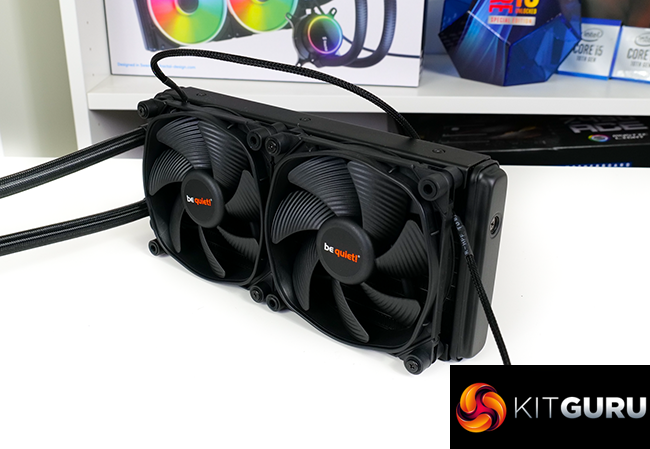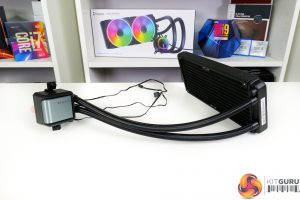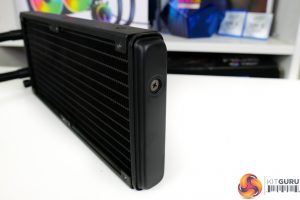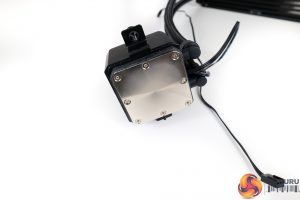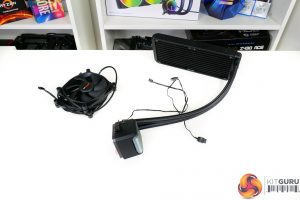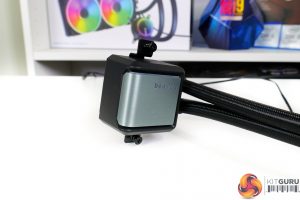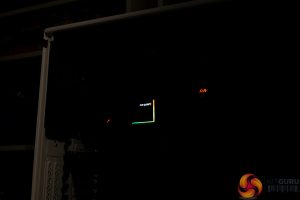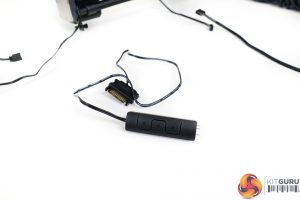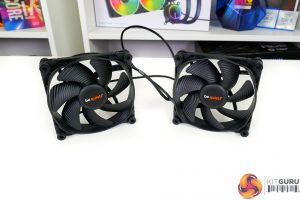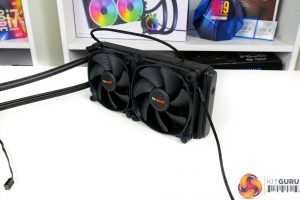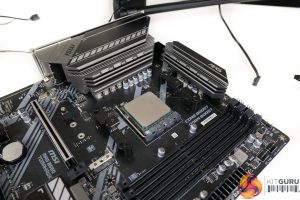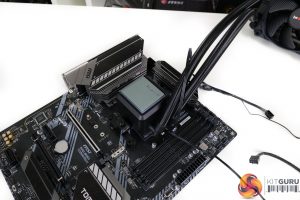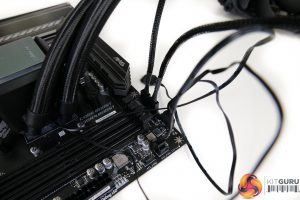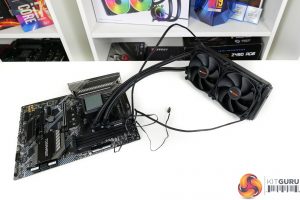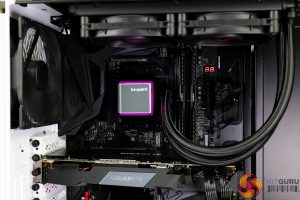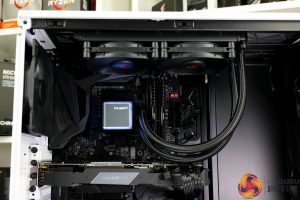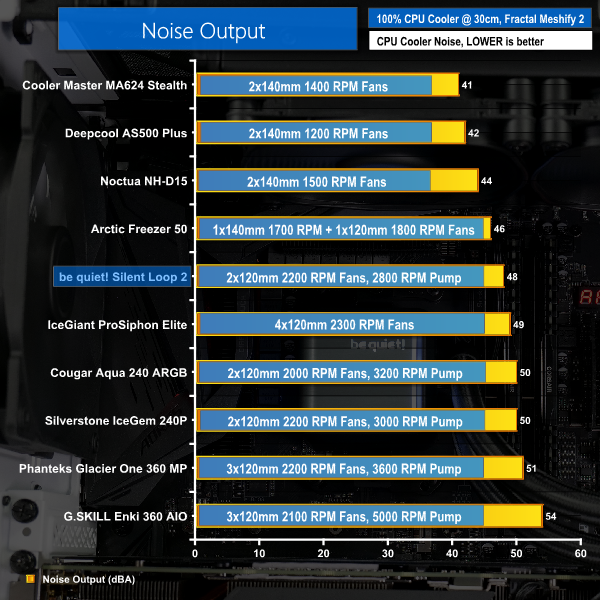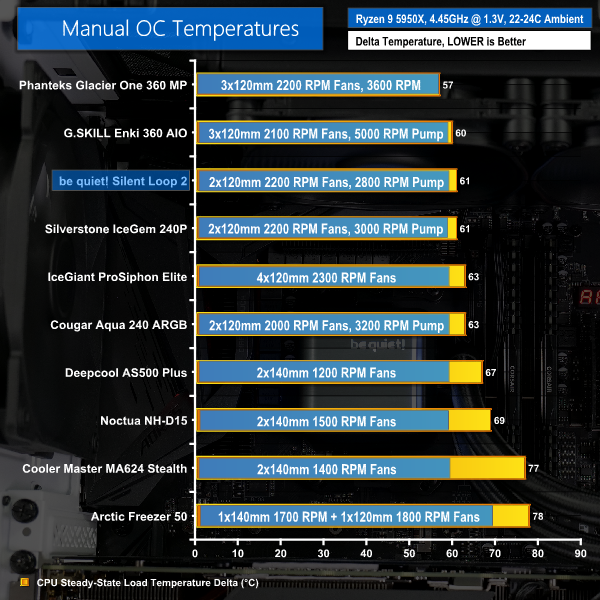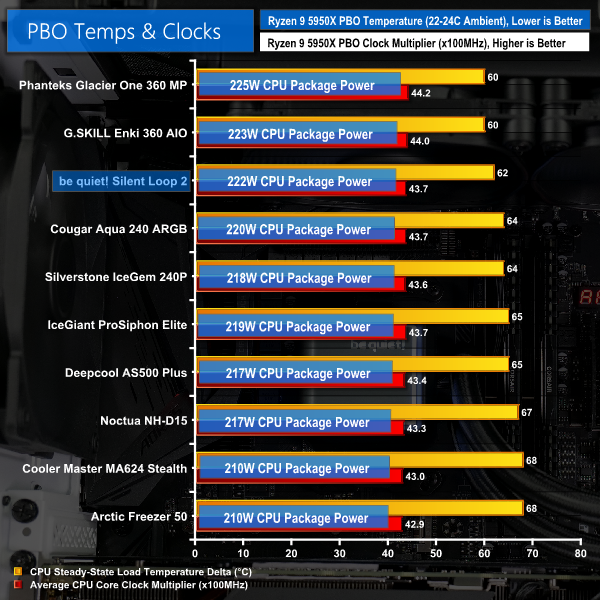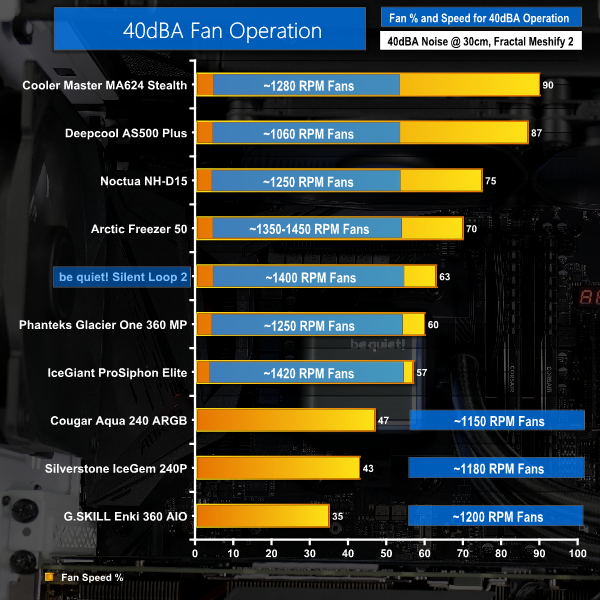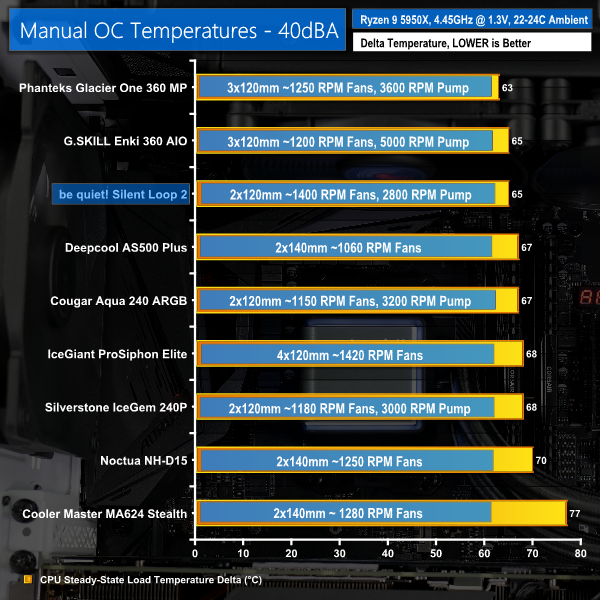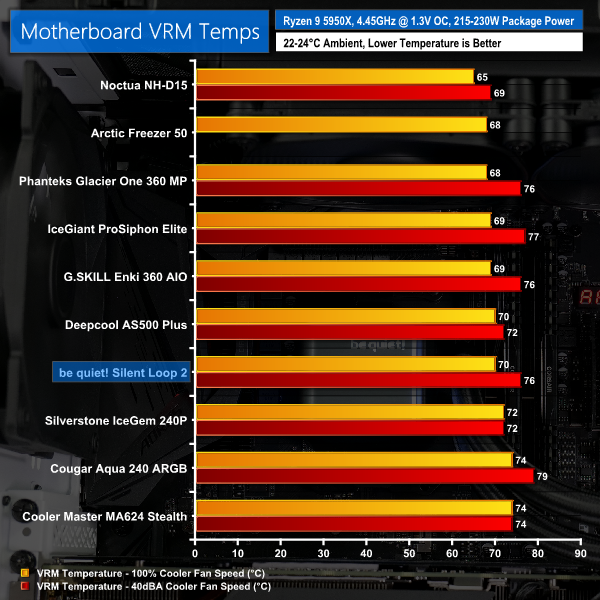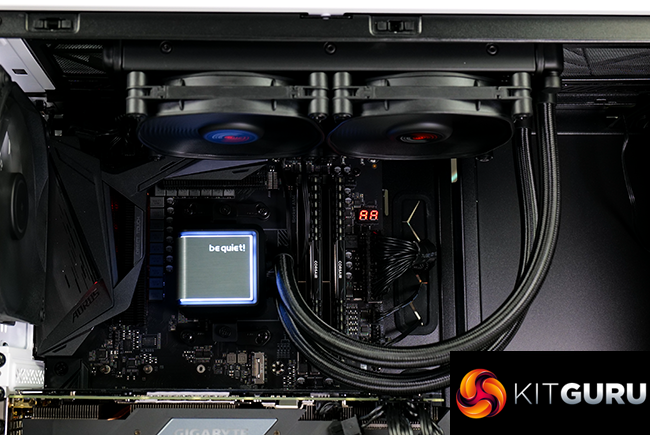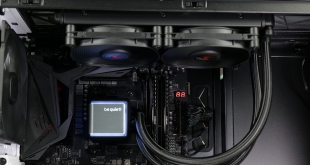
The Silent Loop 2 is be quiet!’s first deployment of ARGB in their AIO liquid cooler line-up. In typical be quiet! fashion, though, the lighting is kept subtle and somewhat discreet rather than flashy and in-your-face. We take a look at how the new 240mm unit performs.
Fundamentally, be quiet! suggests that the Silent Loop 2 is designed for solid performance with quiet operation. While this is obviously ideal for most coolers, some aim for lower noise and some for higher performance. But be quiet! looks to be emphasising a balance between noise and performance.
One unique feature is the inclusion of a refill port to extend the lifespan of your cooler, and be quiet! encourages topping up the fluid after two years of operation.
Available in 120 / 240 / 280 /360mm iterations, we are testing the 240mm version. The be quiet! Silent Loop 2 240mm version is priced around £120 in the UK with availability from early April and with a 3-year warranty.
Specifications and Features:
- 240mm, 27mm-thick aluminium radiator
- 2x120mm be quiet! Silent Wings 3 High-Speed PWM fans
- 2800 RPM 3-pin DC pump unit
- Nickel-plated copper cold plate with over 120 micro fins
- ARGB LED lighting in the pump block unit
- Refillable design with included coolant
- 3-year warranty
- 120 / 240 / 280 / 360mm version available
- Modern Intel and AMD socket support (sTRX4 via a future bracket)
Starting out with the 240mm radiator for the Silent Loop 2, be quiet! uses a conventional 27mm-thick aluminium radiator. This is spray-painted black for better appearance, as is usual for consumer AIOs.
The fin density is what we would describe as average compared to alternative 240mm AIOs. 400mm length tubes with the usual premium sleeving materials are used for aesthetics and quality emphasis.
One unique feature for the Silent Loop 2 is the refill port and included fluid. A user can refill the radiator as a general maintenance measure. This should enhance the usable lifespan of the Silent Loop 2 AIO cooler, especially for those who are comfortable with this reasonably straightforward process. be quiet! recommends a refill after 2 years, according to the manual.
The more cynical side of me does question why a refill port is necessary when quality units from the likes of Asetek have 5 year warranties and no need for top-up ports. But I will let you ponder that point with your own perspective and opinion.
The Silent Loop 2 deploys a nickel-plated copper cold plate. be quiet! suggests that it is a large area cold plate to permit for installation on large CPU heatspreaders for the likes of Ryzen, Intel HEDT, and even Threadripper (via an upcoming bracket that is yet to become available).
According to the be quiet! marketing materials, over 120 micro fins are used for cooling within the cold plate.
There is no clear indication of the OEM and our be quiet! contact would not tell us who the OEM is when we asked. The reason given for this, according to be quiet!, is because they are confident with the quality of the OEM vendor and do not want to make it a point of discussion.
That probably means it is not from the premium CoolIT or Asetek stables as they would be shouted loudly about. The pump-block unit does, however, look similar to the Cougar Aqua 240 AIO mounting design and that used Fly Alpine Electronics Co. Ltd as the Chinese OEM.
Large physical sizing is a clear trait for the pump-block unit. This houses the 2800 RPM, 3-pin power pump which features limited DC control ability. The manual highlights that DC-control voltage should be kept between 9V and 12V, but this control is dependent upon your motherboard fan header control abilities (which are generally good for modern boards).
Edit: Please see comment from be quiet! with respect to speed control for the pump. “While this is technically correct, it’s actually possible to do this if you have a motherboard that allows voltage control of the fan headers (like the ASRock X570 Taichi) as you mention in the conclusion, or with a 3-pin fan controller, or with a cable with built-in transformer. So there are several options, although not that straight-forward. More importantly: where we strictly advised against regulating the pump speed with Silent Loop 1, this time around we even encourage it.”
The large pump unit is a three chamber design which, according to be quiet!, allows the second chamber to offer enough space for the coolant to spread and reduce turbulence, which in turn will reduce noise levels from the pump. There is also use of a 6-pole motor.
Another area that be quiet! points out is that the physically large pump block unit allows for dampening material to minimise noise output. This looks to be a differing design logic compared to alternative pump-block units that may opt for smaller dimensions instead.
A small strip of ARGB lighting is deployed on top of the pump block unit. This strip surrounds the brushed aluminium style cover plate which has a high quality appearance and looks premium even with the light switched off.
RGB lighting control is handled through the conventional motherboard ARGB header control and included software. This is ideal for users, such as myself, who would prefer to minimise supplementary pieces of RGB control software on their system. Arguably better still is that the included in-line controller also permits for a solid degree of RGB LED control.
The be quiet! logo is white LED illuminated but this can be turned off if preferred. For a better look at the Silent Loop 2 cooler's RGB lighting, make sure to watch our video review on YouTube or Vimeo.
Two 120mm Silent Wings 3 PWM High-Speed fans are used with the Silent Loop 2. These 120mm blowers operate at around sub-500 to 2200 RPM rotational speed and are rated for up to 73 CFM of airflow and 3.37mmH20 air pressure.
The fans are non-RGB fans but they do utilise and all-black design with seven blades. Ridges on the blades are used to adjust the turbulence and pressure profile of the airflow. And a funnel shaped frame is designed to accelerate the sub-sonic airflow through the fan frame.
A Fluid Dynamic Bearing and 6-pole fan motor provide mechanical abilities. According to be quiet!, the fans are rated for a 300,000 hour lifespan.
One single 4-pin PWM connector is used for power and speed control via the end of a black braided cable. Just the one cable exiting each fan is a breathe of fresh air, in my opinion, with today's RGB fan market often requiring a silly number of cables for simple connectivity. This is a key positive for cable management and general system tidiness.
AM4 installation starts by using the default AMD backplate supplied with your motherboard. The front-side clips are first removed. This is a little awkward if the motherboard is installed in a case as the backplate will fall down. But the procedure is very easy on a flat surface.
The be quiet! spacers and brackets are screwed into position to make the mounting system for the pump block unit. Again, this is a process that is difficult if the board is vertical inside a chassis and has one wanting another hand. But it is not ludicrously difficult.
With the brackets in position, the system for securing the pump block is fantastic. The spring-loaded screws are easy to tighten and they sit in position easily without battling against other components. Plus, you only have to tighten two screws while holding the heavy pump block unit in place.
Now connect the cables, which is straightforward as there isn’t an overkill number of connections.
The supplementary cables can be managed with relative ease thanks to the use of a 4-pin PWM fan splitter if you like. You can either run RGB through the supplied in-line adapter, or you can use the 3-pin header for ARGB support through motherboard software.
There are several perfectly valid ways to test CPU coolers. We are primarily focussing on the performance of each cooler at 100% fan speed and also when locked to 40dBA noise output. We will focus on cooling performance using a manual overclock and Precision Boost Overdrive, as well as some reference to stock numbers. We will also highlight VRM temperatures.
We decided to test using a chassis as we feel that this is most representative of real-world use cases. It does have some unwanted influences on the test data, as does open-air test bench testing. But we feel that this is a worthwhile trade-off for real-world chassis performance of the coolers.
Our chassis of choice is the Fractal Design Meshify 2 case that Leo reviewed and scored very highly. We like this chassis thanks to its high airflow optimisation and well-vented front and top panels.
The fan configuration is the three included Fractal Dynamic X2 GP-14 fans spinning at full 1000 RPM speed. In addition to the two 140mm front-mounted fans, and single 140mm rear exhaust, we added a be quiet! Pure Wings 2 1000 RPM 140mm fan as roof exhaust for air cooler testing. The aim here was to keep consistency with the airflow path of the liquid coolers which are always roof mounted.
CPU Cooling Test System:
- Processor: AMD Ryzen 9 5950X
- Overclocked Settings: 4.45GHz all-core @ 1.312V (UEFI), Medium LLC – around 1.3V delivered
- Motherboard: Gigabyte B550 Aorus Master
- Memory: 32GB (2x16GB) Corsair Vengeance LPX 3600MHz 16-18-18-36 DDR4 @ 1.35V
- Graphics Card: Gigabyte RTX 2060 Super 0dB Mode
- Chassis: Fractal Design Meshify 2
- Chassis Fans: 2x140mm 1000 RPM Fractal Front Intake, 1x140mm 1000 RPM Fractal Rear Exhaust, 1x140mm 1000 RPM be quiet! Pure Wings 2 Roof Exhaust (for air cooler testing)
- Power Supply: Seasonic Prime TX-1000
- OS SSD: Corsair MP600 NVMe M.2 SSD
- Operating System: Windows 10 Pro 64-bit
Comparison Coolers:
- be quiet! Silent Loop 2 – £199.99, 2x120mm 2200 RPM Fans, 2800 RPM Pump
- Deepcool AS500 Plus – £64.99, 2x140mm 1200 RPM Fans
- Noctua NH-D15 – £80, 2x140mm 1500 RPM Fans
- Cooler Master MA624 Stealth – £99.99 MSRP, 2x140mm 1400 RPM Fans
- Arctic Freezer 50 – £59.99, 1x140mm 1700 RPM + 1x120mm 1800 RPM Fans
- Cougar Aqua 240 ARGB – £89.99-£99.99 MSRP, 2x120mm 2000 RPM Fans, 3200 RPM Pump
- Silverstone IceGem 240P – £119.99, 2x120mm 2200 RPM Fans, 3000 RPM Pump
- Phanteks Glacier One 360 MP – £154.99, 3x120mm 2200 RPM Fans, 3600 RPM Pump
- G.SKILL Enki 360 AIO – $179.99 MSRP, 3x120mm 2100 RPM Fans, 5000 RPM Pump
- IceGiant ProSiphon Elite – £169.99, 4x120mm 2300 RPM Fans
Testing Methodology:
- For testing, we use a 30-minute looped run of Cinebench R23 and record the steady-state CPU temperature at the end of the test. This ensures that the CPU has had ample time to warm up and reach steady state under all of the coolers.
- Ambient is maintained around 22-24 degrees Celsius. Where there is variation beyond this temperature range, we add in extra repeated tests to ensure consistency.
- We also test each cooler with at least two fresh installs (typically three) to mitigate the likelihood of a dodgy mount spoiling results.
Let’s start off with noise performance from each cooler at 100% fan speed.
This is important as it sets the precedence for which coolers we expect to deliver the higher levels of performance based on the faster and louder fans. Assuming that their performance is efficient in comparison to their noise output levels, that is.
The chassis fans are disabled, all case panels are on, and the sound meter is placed 12 inches from the side of the Fractal chassis’ glass side panel – roughly where a desk user will be sat.
be quiet!’s Silent Loop 2 makes a promising start in the noise performance test with its two Silent Wings 3 PWM fans measuring 48 dBA at 12 inches from the chassis side panel. This is a strong result, especially given the 2200 RPM full speed operation of the 120mm blowers.
For comparison, the Silent Loop 2 beats out the competing AIO liquid coolers from our test data set. But it cannot match the preferential noise levels of the air coolers with dual lower speed fans.
If you want even lower noise operation – which we would suggest for standard usage as 48 dBA is still very noticeable – the ability to leverage the sub-500 to 2200 RPM fan speed range is a positive. However, the restricted control abilities of the 3-pin 2800 RPM pump unit will limit how much the noise output can be reduced aside from controlling fan speed.
Our overclocked test is the main stress test and represents a very tough challenge for these CPU coolers. As we are locking the voltage and clock speed, the temperature figures are directly comparable between competing coolers.
We see package powers in the order of 220W for the CPU and wall power levels that exceed 300W for the system. There is a caveat whereby lesser performing coolers force the CPU to run at higher temperature levels. This, in turn, reduces the operating efficiency and dictates that the CPU draws more power. This increased power draw results in higher operating temperatures, thus further negatively affecting the thermal performance.
This small degree of thermal runaway – albeit very limited in system divergence terms – is important with our manually overclocked 5950X CPU. It perhaps seems unfairly weighted against the lesser performing CPU coolers. But it is the reality of real-world operation whereby higher performing CPU coolers can sometimes show disproportionately better temperature performance at the higher thermal load levels.
Note the use of delta temperature data in our charts and factor in your own ambient conditions for reference.
With full speed fans and pump unit unleashed at our Ryzen 9 5950X overclocked test, the be quiet! Silent Loop 2 performs well.
We recorded a delta temperature of 61 degrees – which translates into low-to-mid 80s real operating CPU temperature in typical ambient conditions. This is a positive result and has the Silent Loop 2 matching the physically bigger Silverstone IceGem 240P while beating out the Cougar dual-fan AIO, as well as the air CPU coolers.
In fact, the performance from be quiet!’s 240mm AIO is close to that of G.SKILL’s 360mm liquid cooler which also operates with a trio of high-speed fans and a high-RPM pump unit.
Given the preferential noise output and slimmer form factor versus Silverstone’s similarly priced IceGem 240P, we would call this initial temperature test a minor victory for the be quiet! Silent Loop 2.
We won’t put too much emphasis on PBO results, but we will spend some time to quickly analyse them using our full fan speed data.
With 90C the maximum target temperature for PBO, we are looking for the cooler that achieves the balance between lower temperature operation and higher PBO clock speeds. Higher clocks with lower temperatures are better. But one cooler may run at slightly higher temperatures than another, albeit with higher clock speeds, so look out for that.
In essence, this test is showing us how far the coolers can be pushed while keeping a sensible 90C maximum. Or whether there is more room for pushing clocks and power delivery beyond the PBO limits while still sticking to a 90C target.
be quiet! again does well in this cooling test with the Silent Loop 2 240mm unit. We see a performance level that is only bested by the 360mm AIOs from our data set. Cougar’s and Silverstone’s competing 240mm options are beaten by a measurable and repeatable margin.
Managing a little over 220W of CPU package power and returning a mid-80s CPU operating temperature highlights that the Silent Loop 2 has more performance left in the tank. That point is also notable with the 4.37GHz average operating core clock for our 5950X CPU, which is comparable to the 240mm units but not quite as high as the 360mm pack leaders.
We are confident in saying that the Silent Loop 2 is the best of the non-360mm AIO coolers in our data set for this PBO test. Though that is also largely to be expected given the £120 price point.
We can quickly brush over the stock test results as the roughly 129W package power from our 5950X is not high enough to stress the be quiet! Silent Loop 2 cooler properly. Plus, the PB2 algorithm means that the temperature levels are typically very similar as the clock speeds change dynamically.
Even with the PB2 shackles and low power output from the chip, we see the Silent Loop 2 at 100% fan speed hovering around 55C with clock speeds in the order of 3880-3890MHz under heavy load. These results are comparable to the Cougar and Silverstone 240mm AIOs but they lag the more expensive 360mm AIO slightly, as we have seen throughout our thermally-focussed tests.
Having assessed the coolers at full fan speed, we see clear separation between the AIO cooler performance with their high-speed, loud fans and the competing lower-speed fan air coolers. As such, we have a look at some test results with the noise levels locked to 40dBA on each CPU cooler.
This noise-normalised test is perhaps a little unfair towards AIO liquid coolers and air CPU coolers with dense fin arrays. Those designs need high pressure fans to penetrate the dense arrays and this usually comes in the form of high-speed and loud fans.
With that said, noise is noise when it comes to user tolerance, so the way in which a cooler is designed and optimised is not necessarily a concern to a user simply wanting low-noise, 40dBA-type operation.
Dropping the Silent Loop 2 cooler’s pair of Silent Wings 3 120mm PWM fans to 63% speed achieves our desired 40dBA target. This translates into an operating speed of around 1400 RPM for both fans with the 3-pin powered pump unit still locked at 2800 RPM.
This is actually less of a reduction from maximum fan speed as compared to the other AIOs in our data set. That is despite be quiet!’s Silent Wings 3 PWM fans being rated at a high – 2200 RPM – maximum speed. This is – at least on the face of it – a testament to the noise efficiency of the Silent Wings 3 120mm fans.
We will have to see how performance bears out at 40dBA operation.
Let’s see how the demanding OC stress test thermal performance hierarchy changes with a 40dBA lock on the noise output.
The Silent Loop 2 does a good job at maintaining much of its cooling performance despite running at 63% of its maximum fan speed, as dictated by the 40dBA lock. Now, we see the be quiet! 240mm AIO outperforming the competing dual-120mm liquid coolers as well as the dual-fan air coolers. In fact, the Silent Loop 2 matches G.SKILL’s 360mm cooler in terms of temperature numbers, but the well-designed Phanteks and Asetek 360mm AIO is a step too far.
This is a positive result for the Silent Loop 2 and emphasises the superb noise-based performance efficiency of be quiet!’s quality Silent Wings 3 120mm fans. One could certainly argue that be quiet! is living up to the company name when factoring in cooling performance.
We highlight VRM temperatures when using each cooler on our Gigabyte B550 Aorus Master motherboard with the overclocked Ryzen 9 5950X. Do note that the results are heavily influenced by the specific layout of the Gigabyte B550 Aorus Master test motherboard with respect to top-side or rear IO-side VRM components. So your findings may vary if you have a different motherboard VRM layout and heatsink design.
If we now look at VRM temperatures when running our manually overclocked test at full fan speed, the Silent Loop 2 is sub-par. Of course, this is heavily influenced by radiator and therefore fan positioning inside one’s chassis. As well as the specific design and positioning of one’s motherboard VRM heatsink.
With all of that said, the Silent Loop 2 is close to the bottom of our chart with VRM temperatures in the order of 70C. And the 240mm unit is also poor when focussed on 40dBA locked fan speed performance – registering a mid-70s VRM sensor result.
If you want a CPU cooler that has the benefit of helping out the VRMs, the Silent Loop 2 is not a strong option if your system and test configuration roughly matches ours.
With the Silent Loop 2, be quiet! is delivering solid performance from the 240mm unit when tested with our AM4 system. We saw performance numbers that were close to those of more expensive 360mm AIO units, and that’s good with a hot 5950X.
One particular strength is the good job that be quiet! does at balancing the noise levels with thermal performance. There is a good ability to tune down the noise for 40dBA cooling performance. And the pump noise level was not obtrusive either, though it does feature limited speed control with its 3-pin DC connection.
The be quiet! Silent Wings 3 High-Speed PWM fans are strong performers. They also look good in our opinion, despite not featuring any lighting. We wouldn’t be surprised if some people would like some degree of RGB lighting on the fans. That is individual preference, though, and we certainly will not complain given the excellent noise-balanced performance.
While we liked the RGB lighting on the pump block unit – as the border is subtle but stylish with reasonable control options – £120 is expensive for this calibre of unit with no RGB fans. That may appeal to some users who just want a subtle flash of RGB inside their system. But £120 is firmly in RGB pump/block unit AND fan territory.
The 3-year warranty is disappointing as 5 years is expected from premium brands in today’s market, especially at this price point. Then again, some users may prefer the inclusion of a refill port and encouraged self-maintenance, so that is a factor to bear in mind.
Overall, we like the Silent Loop 2 thanks to the strong noise-balanced performance delivered by Silent Wings 3 PWM fans. The pricing is certainly on the expensive side for a 240mm AIO and the warranty is disappointing. However, the subtleness of the RGB lighting, alongside the usual be quiet! quality standard, will appeal to many.
The be quiet! Silent Loop 2 240mm is listed as ‘coming soon' to CCL HERE.
Discuss on our Facebook page HERE.
Pros:
- Solid overall performance.
- Good noise-balanced performance.
- Excellent Silent Wings 3 PWM fans.
- Subtle but good-looking ARGB lighting.
- Refill port will appeal to some users.
Cons:
- Expensive at £120 in the UK.
- Only 3 year warranty.
- Limited DC-powered pump speed control – only 9V to 12V motherboard header control.
KitGuru says: £120 certainly is not cheap for a 240mm AIO cooler with minimal RGB lighting and a 3-year warranty. However, the be quiet! Silent Loop 2 does a good job at offering strong noise-balanced performance thanks to the superb Silent Wings 3 fans.
 KitGuru KitGuru.net – Tech News | Hardware News | Hardware Reviews | IOS | Mobile | Gaming | Graphics Cards
KitGuru KitGuru.net – Tech News | Hardware News | Hardware Reviews | IOS | Mobile | Gaming | Graphics Cards


